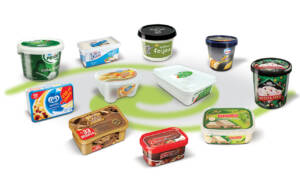What Do We Mean ” In-Mold Labeling (IML) Technology”?
In-Mold Labeling (IML) Technology refers to a manufacturing process commonly used in the production of plastic products, particularly containers, and packaging. This innovative technique involves integrating labels or decorations directly into the mold during the injection molding process.
In this technology, a pre-printed label or decoration is put into the mold before injecting the plastic material. When the plastic is injected into the mold, it fuses with the label, creating a seamless bond between the label and the plastic product.
In the domain of product fabrication, achieving a harmonious balance between aesthetics, resilience, and efficiency is crucial. In-Mold Labeling (IML) technology emerges as a pioneering method that seamlessly incorporates decorative elements into plastic products throughout their molding stage. This transformative process not only enhances the visual appeal of products but also introduces a spectrum of advantages, setting new benchmarks for the synergy of design excellence and functional efficiency in manufacturing.

IML (In-Mold Labeling) THROUGH THE AGES:
The IML technology approach arose as a remedy to enhance the visual appeal and resilience of labeled items, especially in the context of plastics and packaging.
- 1960s – 1970s: The foundational ideas and early trials associated with in-mold labeling began to crystallize during this timeframe. Nevertheless, the procedures were not as sophisticated as they are in contemporary times.
- 1980s: This era represented a pivotal moment for in-mold labeling (IML). Progress in printing technology, materials, and molding processes played a crucial role in the enhancement and widespread adoption of IML techniques.
- 1990s: IML technology witnessed a surge in adoption and refinement, primarily in Europe and subsequently in other global regions. Innovations in printing methods, label materials, and injection molding processes played a pivotal role in elevating the quality and feasibility of IML applications.
- 2000s: significant strides were made in in-mold labeling (IML) technology. The 21st century ushered in substantial improvements, with the advent of high-resolution graphics enabling more vibrant and intricate label designs.
Moreover, the evolution of more versatile and durable label materials broadened the scope of potential applications for IML across diverse industries. This encompassed areas such as food packaging, agriculture, cosmetics, automotive parts, and household goods.
Why IN Mold Labeling Is essential and Famous ?
Effective product labeling is crucial for the success of rubber and plastic products. The incorporation of high-quality labels significantly enhances the value of these products, contributing to their durability and extended lifespan.
The visual appeal of a plastic product’s design plays a pivotal role in attracting and enticing potential buyers. In the realm of consumer psychology, it has been established that emotions often guide purchasing decisions. People tend to make buying choices based on their emotional response to a product, influenced largely by its visual presentation.

Advantages of IML Technology :
By using PP (Polypropylene) material in IML which has Some of the key properties of polypropylene include:
- Lightweight
- Strong and durable
- High resistance to chemicals and temperatures
- Versatile
- Melt and reform multiple times

100% recyclable materials are incorporated into the production process of polypropylene (PP), ensuring an environmentally friendly approach at every stage of manufacturing.
Utilizing advanced technology and efficient In-Mold Labeling (IML) robot systems, the manufacturing process is executed swiftly and with precision in specialized facilities, eliminating human contact. This meticulous approach not only underscores the significance of public health but also ensures a hygienic production environment, emphasizing a commitment to both public well-being and environmental sustainability.
The product is achieved through a streamlined manufacturing process that boasts enhanced efficiency in both time and cost. This superior efficiency, when juxtaposed with packaging products undergoing similar processes, is the result of meticulous process management orchestrated by seasoned designers and manufacturers.
During the manufacturing process, the packaging’s durability is heightened through a seamless adhesion of the label. This meticulous integration ensures a robust bond between the packaging material and the label, contributing to an overall increase in product longevity and resilience.
Components of an In-Mold Labeling (IML) robot include:
- Magazine unit .
- Label transfer unit .
- Main arm.
- Main axis .
- Stacking unit .
- Conveyor .

These components work together to automate the in-mold labeling process, enhancing efficiency and precision in product decoration.
MARKROBOTIC Has more than 14 years of experience and is well known for high-performance IML ROBOT ,EOAT System , Handle Fitting Machines, Medical Automation Systems as well as innovative downstream solutions that include Product/Decoration Inspection, Assembly-and Box Filling Systems.




